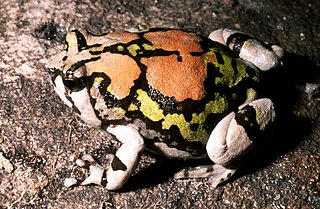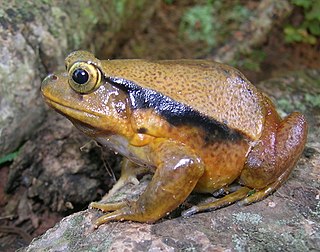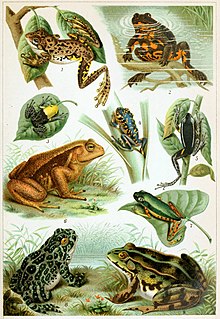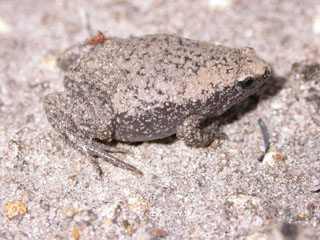
The Cophylinae are a subfamily of microhylid frogs endemic to Madagascar. It has over 100 species in eight genera. Members of this subfamily range from minute to fairly large, and they are highly ecologically diverse. DNA barcode research has revealed a significant taxonomic gap in this subfamily, and an estimated 70+ candidate species were identified. Many of these have subsequently been described, as well as numerous new discoveries.

Plethodontohyla is a genus of microhylid frogs endemic to Madagascar.

The Scaphiophryninae are a subfamily of microhylid frogs native to Madagascar.

Paradoxophyla is a small genus of microhylid frogs endemic to Madagascar.

Anodonthyla boulengerii is a species of frog in the family Microhylidae. It is endemic to Madagascar. Its natural habitats are subtropical or tropical moist lowland forests, subtropical or tropical moist montane forests, and heavily degraded former forest. It is threatened by habitat loss.

Dyscophus guineti, the false tomato frog, is a species of frog in the family Microhylidae. It is endemic to Madagascar. Its natural habitats are subtropical or tropical moist lowland forest, subtropical or tropical swamps, swamps, freshwater marshes, intermittent freshwater marshes, and heavily degraded former forest. It is threatened by habitat loss.

Paradoxophyla palmata is a species of frog in the family Microhylidae. It is endemic to Madagascar. Its natural habitats are subtropical or tropical moist lowland forests, intermittent freshwater marshes, and heavily degraded former forest. It is threatened by habitat loss.

Plethodontohyla notosticta is a species of frog in the family Microhylidae. It is endemic to Madagascar. Its natural habitats are subtropical or tropical moist lowland forests, subtropical or tropical moist montane forests, and heavily degraded former forest. It is threatened by habitat loss.

Rhombophryne is a genus of microhylid frogs endemic to Madagascar. It is currently estimated to include more than 23 species, but only 19 of these are currently described. The common name 'diamond frog' has been proposed and used for members of this genus.
Anilany helenae is a species of frog in the microyhlid subfamily Cophylinae. It is the only species in the monotypic genus Anilany, and is endemic to central Madagascar.

Stumpffia pygmaea is a species of frog in the family Microhylidae. It is endemic to Madagascar, where it is known from only two islands, Nosy Be and Nosy Komba. Its natural habitats are subtropical or tropical moist lowland forests, plantations, Stumpffia pygmaea,males with a snout-vent length of 10–12.5 mm (0.39–0.49 in),then females with a snout-vent length of 11 mm (0.43 in).Stumpffia pygmaea is a terrestrial microhylid frog ,and heavily degraded former forest. It is threatened by habitat loss.

A tree frog is any species of frog that spends a major portion of its lifespan in trees, known as an arboreal state. Several lineages of frogs among the Neobatrachia have given rise to tree frogs, although they are not closely related to each other.
Burrowing frog may refer to several fossorial frog species:

Rhombophryne coudreaui is a species of frog in the family Microhylidae. It is endemic to northeastern Madagascar. The specific name coudreaui honours Jean Coudreau, a colonial forestry administrator in Madagascar who collected the holotype. Common names Coudreau's frog and Betampona digging frog have been coined for it.

Plethodontohyla alluaudi is a frog belonging to the Madagascar-endemic subfamily Cophylinae of the family Microhylidae. It is endemic to southeastern Madagascar. It is a terrestrial and fossorial frog that occurs in rainforest, including littoral forest. Despite being locally abundant, it is a difficult frog to find.
Anodonthyla moramora is a species of microhylidae frog. This species is native to Madagascar.
Anodonthyla hutchisoni is a species of microhylidae frog. This species is native to Madagascar and can be found in lowland rain forests.
The marbled frog is a species of ground-dwelling frog in the family Myobatrachidae native to northern and north-eastern Australia, and southern New Guinea.















